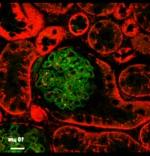Lab 研究

Myosins are cytoskeletal proteins that use the energy of ATP hydrolysis to move along actin filaments (see this 动画 of skeletal myosin ATPase cycle at the Vale lab website for an illustration of how ATP hydrolysis is coupled to myosin movement).
The first myosin to be discovered was myosin II in skeletal muscle, which is responsible for muscle contraction. Since the discovery of the first non-muscle myosin in 1972, myosin family has expanded and now consists of a wide variety of actin-dependent motors, including many myosins found in non-muscle cells. We are interested in the roles that myosins play in non-muscle cells, primarily in the epithelial cells of the kidney glomerulus, 被称为 足细胞.
Much of the work in the lab centers on one member of myosin superfamily, called myosin 1e. We found that mice lacking myosin 1e develop defects in glomerular organization and functions soon after birth. The defects observed in our knockout mouse model are reminiscent of those seen in inherited human glomerular diseases, such as familial focal and segmental glomerulosclerosis (FSGS). FSGS is the leading cause of steroid-resistant nephrotic syndrome, a severe kidney disease that often results in kidney failure. Recent successes in mapping out genes responsible for FSGS have resulted in identification of potential drug treatments for some subtypes of the disease. Recent genetic studies have also identified mutations in the MYO1E gene in patients with FSGS. Our hope is that identification of myosin 1e functions in 足细胞 will provide clues to its role in the pathogenesis of human glomerular disease and potential avenues for diagnosis and treatment of this condition. We are using myosin 1e-null 足细胞 to identify defects in cell motility and cell adhesion that lead to abnormal glomerular filtration in myosin 1e-knockout mice and in patients with MYO1E mutations. These studies were supported by a grant from the Nephcure Foundation and are currently supported by an R01 grant from the NIH/NIDDK. For an update on our research on myosin functions in 足细胞, you can watch this multimedia presentation.
Chronic kidney disease is a major public health problem in the US and worldwide. Many cases of chronic kidney disease occur in patients with high blood pressure, 糖尿病, and obesity. The propensity of a patient with these conditions to develop chronic kidney disease appears to be determined to a large extent by genetic factors, and some ethnic groups (African-Americans, 拉美裔, and Native Indian patients) are disproportionately affected by hypertension- or 糖尿病-associated kidney disease. Our preliminary findings indicate that myosin 1e expression in the kidney is altered in mouse model of 糖尿病, and further investigation of the role of myosin 1e in 糖尿病 may uncover a role for this protein or its mutant variants in diabetic kidney disease. Our work on the role of myosin 1e in diabetic kidney disease was supported by the American Diabetes Association.
